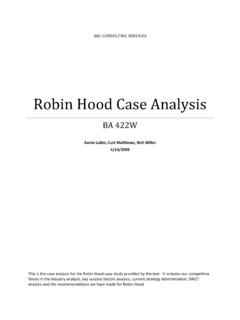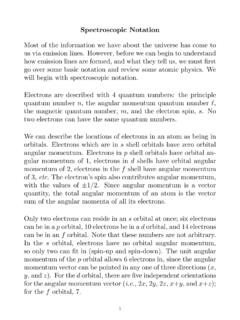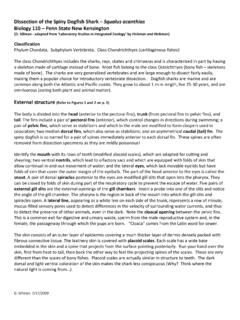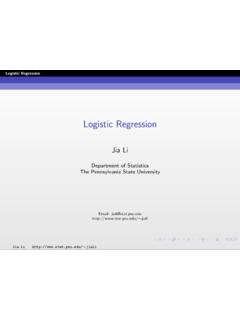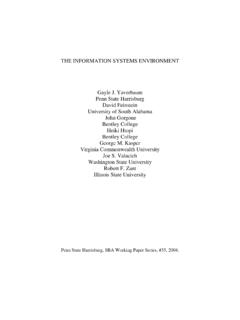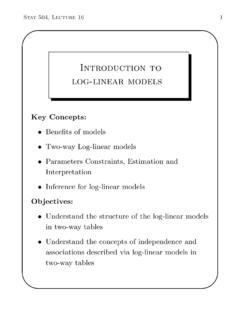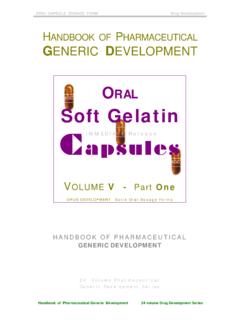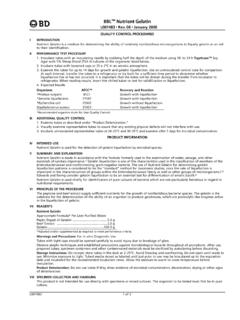Transcription of Gelatin Sepharose - Pennsylvania State University
1 Instructionsi 71-7094-00 Edition ADGelatin SepharoseGelatin Sepharose 4B is gelatincoupled to Sepharose 4B by thecyanogen bromide binds specifically tofibronectin, which is a highmolecular weight glycoproteinfound on the surfaces of many celltypes and present in manyextracellular fluids includingplasma. Gelatin Sepharose 4B hasbeen designed for the purification orremoval of fibronectin. p2 Table 1. Medium 8 mg Gelatin /ml drained mediumAvailable capacity:approx. 1 mg human plasma fibronectin/mldrained mediumBead structure:4% agaroseBead size range:45 165 mAverage bead size:90 mMax linear flow rate*: 75 cm/h at 25 C, HR 16/10 column,5 cm bed heightpH stability**:Long term:3 10 Short term:3 10 Chemical stability:Stable to all commonly used aqueous buffersPhysical stability:Negligible volume variation due to changes inpH or ionic strengthStorage:20% ethanol* Linear flow rate =volumetric flow rate (cm3/h)column cross-sectional area (cm2)** The ranges given are estimates based on our knowledge andexperience.
2 Please note the following:pH stability, long term refers to the pH interval where the gel is stableover a long period of time without adverse effects on its subsequentchromatographic stability, short term refers to the pH interval for regeneration the mediumGelatin Sepharose 4B is supplied pre-swollen in 20%ethanol. Prepare a slurry by decanting the ethanolsolution and replacing it with binding buffer in aratio of 75% settled medium to 25% buffer. Thebinding buffer should not contain agents whichsignificantly increase the viscosity. The column may p3be equilibrated with viscous buffers at reduced flowrates after packing is Sepharose 4B medium1. Equilibrate all material to the temperature atwhich the chromatography will be De-gas the medium Eliminate air from the column dead spaces byflushing the end pieces with buffer. Make sure noair has been trapped under the column net.
3 Closethe column outlet with a few centimeters of bufferremaining in the Pour the slurry into the column in one continuousmotion. Pouring the slurry down a glass rod heldagainst the wall of the column will minimize theintroduction of air Immediately fill the remainder of the column withbuffer, mount the column top piece onto thecolumn and connect the column to a Open the bottom outlet of the column and set thepump to run at the desired flow rate. This shouldbe at least 133% of the flow rate to be usedduring subsequent chromatographic , the maximum flow rate, see Table 1, istypically employed during :If you have packed at the maximum linearflow rate, do not exceed 75% of this insubsequent chromatographic procedures. p47. Maintain the packing flow rate for 3 bed volumesafter a constant bed height is an adaptorAdaptors should be fitted as follows:1.
4 After the medium has been packed as describedabove, close the column outlet and remove the toppiece from the column. Carefully fill the rest ofthe column with buffer to form an upwardmeniscus at the Insert the adaptor at an angle into the column,ensuring that no air is trapped under the Make all tubing connections at this stage. Theremust be a bubble-free liquid connection betweenthe column and the Slide the plunger slowly down the column so thatthe air above the net and in the capillary tubings isdisplaced by eluent. Valves on the inlet side of thecolumn should be turned in all directions during thisprocedure to ensure that air is Lock the adaptor in position on the mediumsurface, open the column outlet and start the eluentflow. Pass eluent through the column at thepacking flow rate until the medium bed is the adaptor on the medium surface column is now packed and equilibrated andready for use.
5 P5 BindingFibronectin binds to Gelatin Sepharose 4B at oraround physiological pH and ionic or Tris-HCl buffered saline have beencommonly used as binding buffer for purification orremoval of fibronectin has a tendency to adsorb to glass,it is recommended to only use siliconized glass toprevent adsorption and loss or the sample has been loaded, wash the mediumwith binding buffer until the base line is can be eluted from Gelatin Sepharose 4 Bin different ways. Use a buffer containing a bromide salt, bromide or potassium bromide, and pHlower than the binding buffer. A recommendedbuffer is M sodium acetate, pH ,containing M sodium bromide or potassiumbromide. Elute adsorbed fibronectin with 8 M urea in thebinding buffer. Fibronectin can also be eluted by adding arginineto the binding buffer. p6 RegenerationDepending of the nature of the sample, GelatinSepharose 4B may be regenerated for re-use bywashing the gel with 2-3 bed volumes of alternatinghigh pH ( M Tris-HCl, M NaCl, pH ) andlow pH ( M sodium acetate, M NaCl, pH )buffers.
6 This cycle should be repeated 3 timesfollowed by re-equilibration with 3-5 bed volumesof binding detergent or denaturing agents ( 8 M urea)have been used during the purification, these canalso be used in the washing some applications, substances like denaturatedproteins or lipids do not elute in the regenerationprocedure. These can be removed by washing themedium with a detergent solution, X-100 at 37 C for one immediately with at least 5 bedvolumes of binding Sepharose 4B should be stored in neutral pHat 4 8 C in presence of a bacteriostat, 20%ethanol. p7 Further informationCheck more information. Useful information is alsoavailable in the Affinity Chromatography Handbook,see ordering informationProductPack sizeCode Sepharose 4 B 25 ml17-0956-01 Gelatin Sepharose 4 B500 ml17-0956-03 LiteratureAffinity Chromatography Handbook, 118-1022-29 Principles and MethodsTrademarksSepharose is a trademark of AmershamBiosciences Limited.
7 Amersham andAmersham Biosciences are trademarks ofAmersham plc. Drop Design is a trademarkof Amersham Biosciences is a trademark of Union CarbideChemicals and Plastics Co. Amersham Biosciences AB 2002 All rights reservedAll goods and services are sold subject to theterms and conditions of sale of the companywithin the Amersham Biosciences groupwhich supplies them. A copy of these termsand conditions is available on Biosciences ABSE-751 84 Uppsala, SwedenAmersham Biosciences UK LimitedAmersham Place, Little ChalfontBuckinghamshire, England HP7 9 NAAmersham Biosciences Corporation800 Centennial AvenuePiscataway, NJ 08855, USAA mersham Biosciences Europe GmbHPostfach 5480D-79021 Freiburg, GermanyAmersham Biosciences Building, 3-25-1 Shinjuku-ku, Tokyo 169-0073, JapanProduced by Wikstr ms, Sweden 1021175, matter.
8 Licence 341 051


